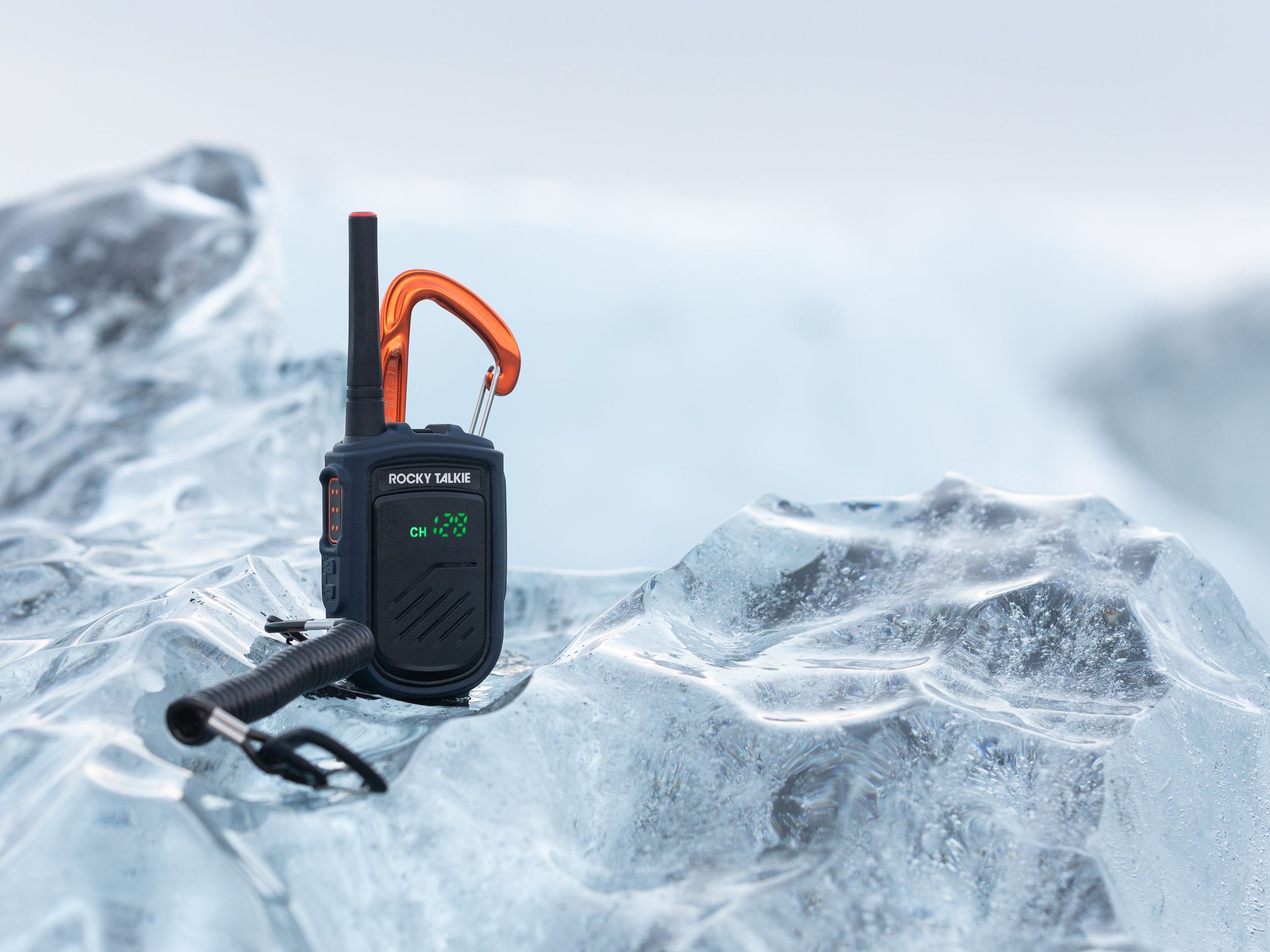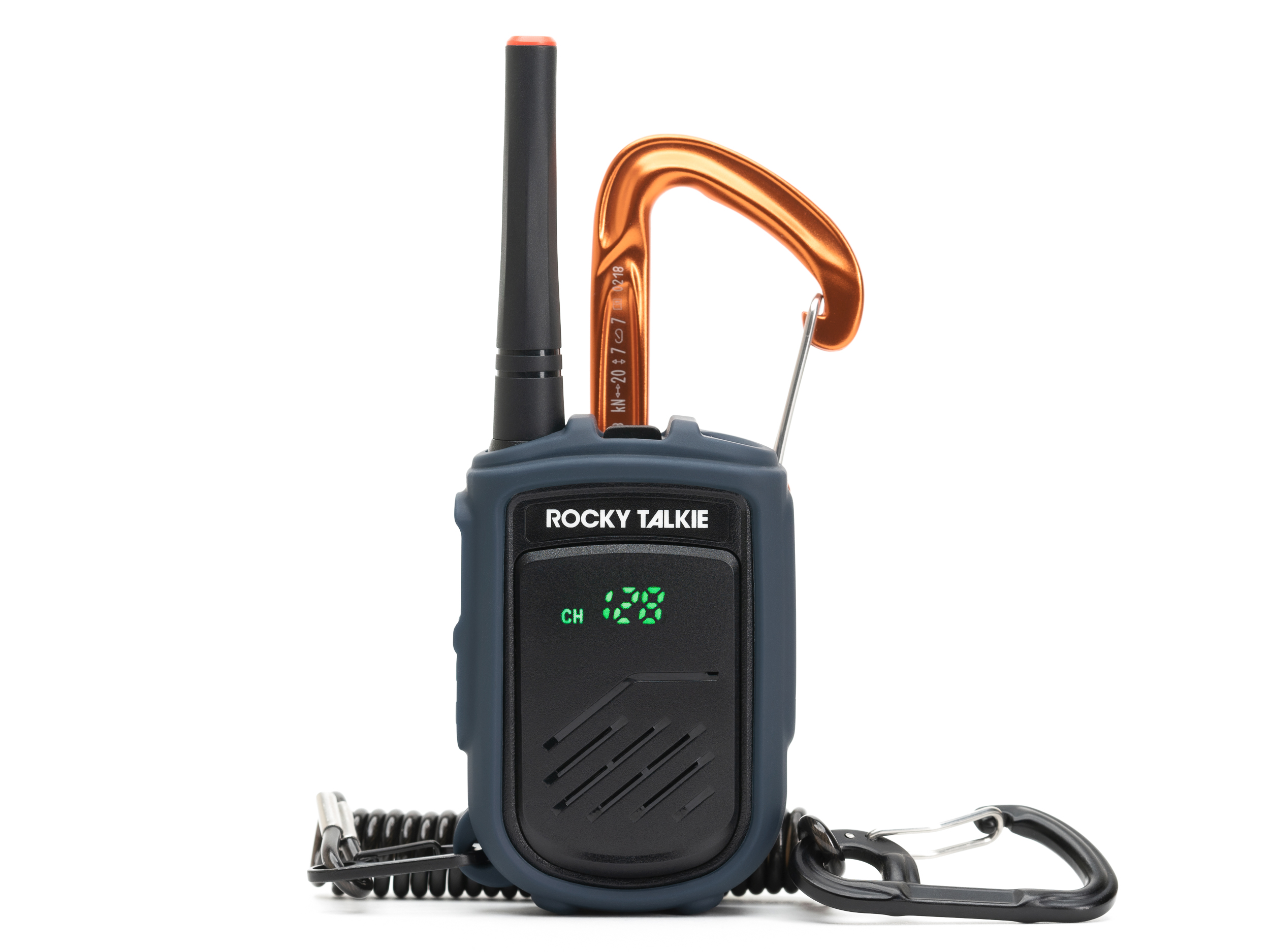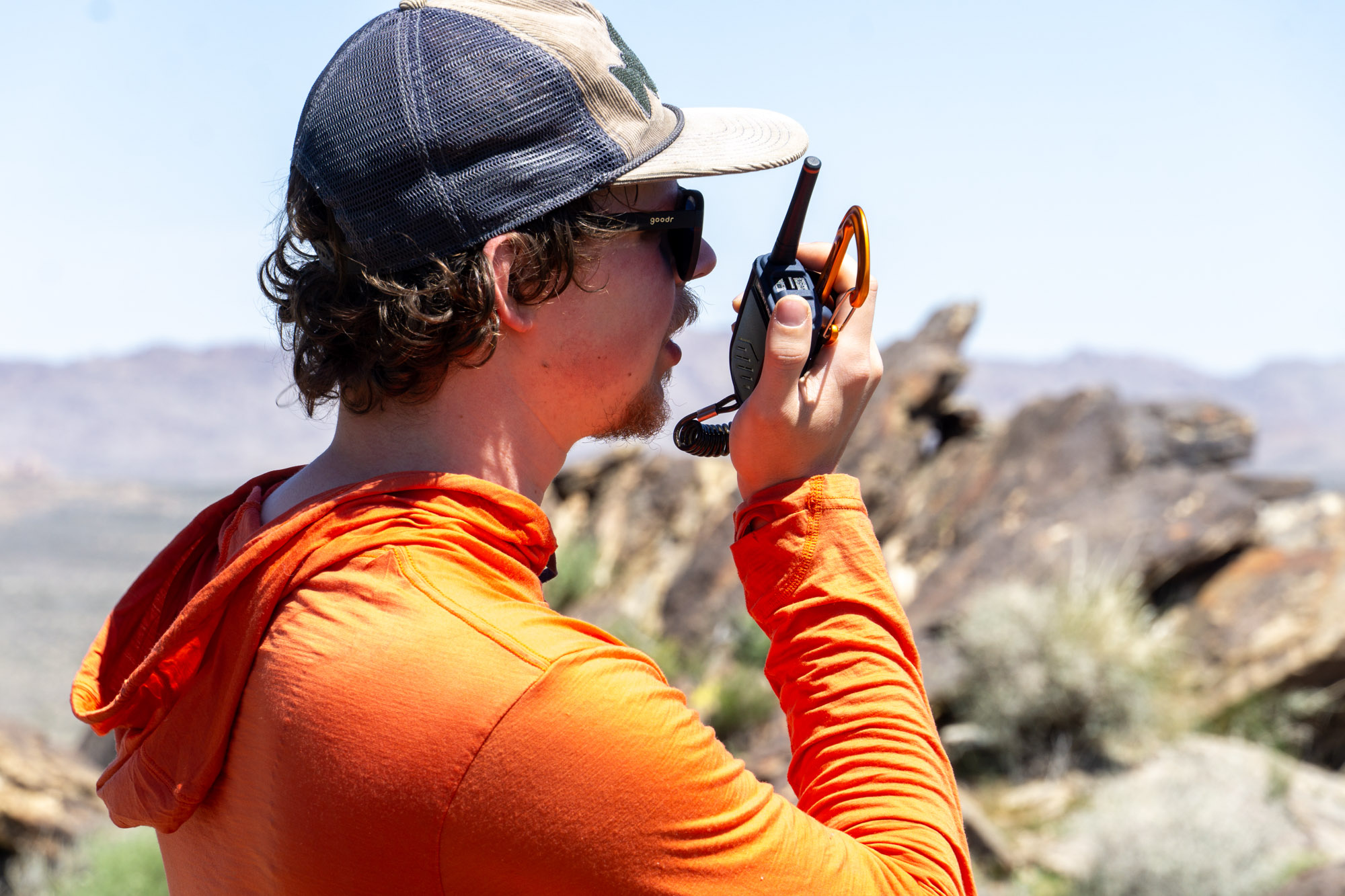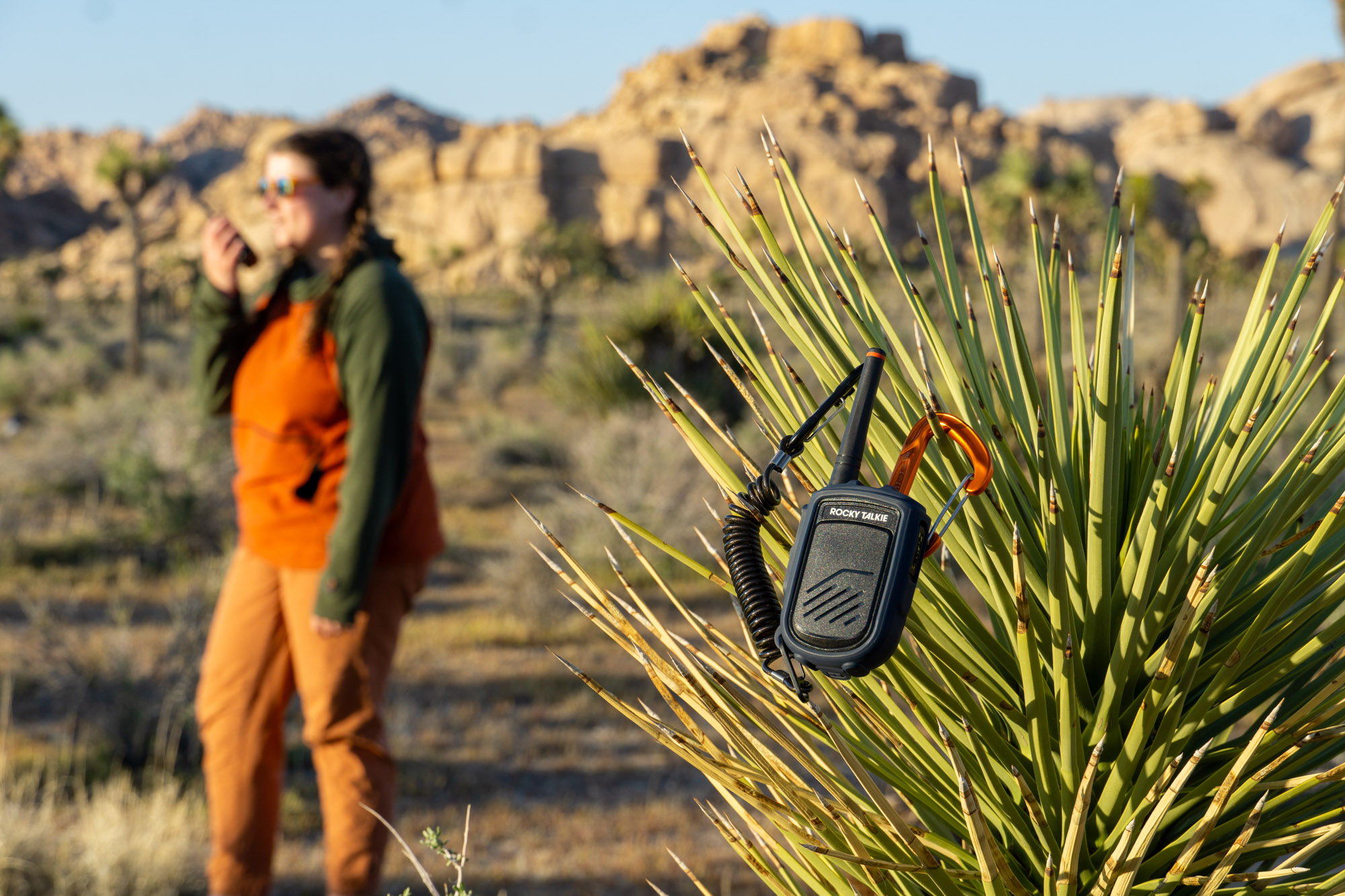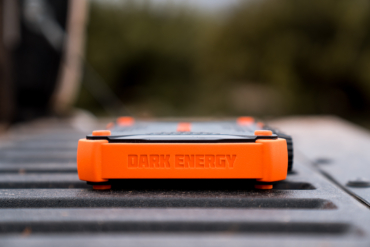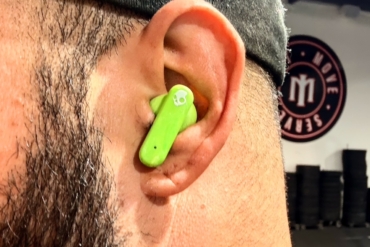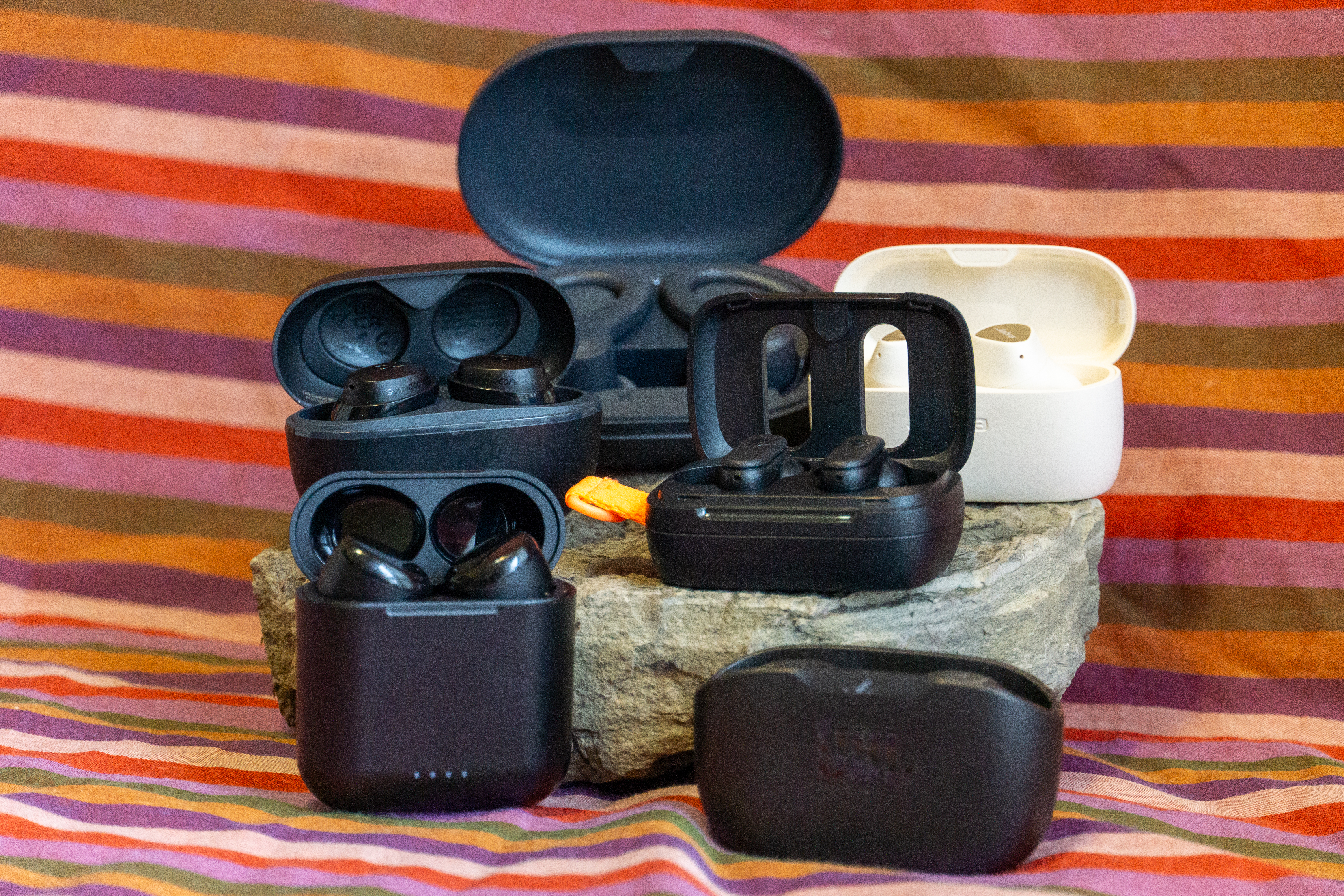After a few potentially disastrous communication breakdowns while multipitch rock or ice climbing, I decided to commit to two-way radios. The Rocky Talkie had just hit the scene, and I thought the branding was “cute.” Visibly, the units looked like standard Family Radio Service (FRS) with armoring.
I had demolished many FRS radios at that point, so the armored Rocky Talkies looked promising. But I didn’t expect drastic improvements in functionality over other FRS radios.
I tested a pair of the Rocky Talkies on two multipitch ice climbing trips in Alaska over a year. The climbing objectives were in very remote regions and were often first ascent attempts. The temperatures never exceeded the teens, and the radios were subjected to unforgiving treatment.
Most importantly, my team and I relied on the Rocky Talkie in potentially life-threatening situations, and they never let us down.
In short: The Rocky Talkie is an incredibly durable FRS radio with impressive range and battery life. If your adventures require reliable communication, and you don’t need waterproof radios, I think the Rocky Talkie is the best FRS option for most.
Looking for a new walkie talkie? Check out how the Rocky Talkie Mountain Radio compares to the rest of the radios out there in GearJunkie’s Best Walkie Talkie Buyer’s Guide.
-
Range
8.0
-
Battery Life
9.0
-
Ease of Use
8.0
-
Weight & Size
9.0
- Radio Class: FRS
- Channels: 22
- Privacy Codes: 121 (CTCSS and DCS)
- Frequency Range: 462 to 467 MHz
- Wattage: 0.5 W, 2 W
- Battery Capacity: Rechargeable 1550 mAh Li-ion
- Dimensions: 9.3 cm tall x 6.3 cm wide x 2.8 cm thick
- Waterproof Rating: IP56 splashproof
- Weight: 7.9 oz. (with leash)
Pros
- Rugged and durable
- Easy to operate
- Buttons work well with gloves
- Impressive range
- Clear audio
Cons
- No NOAA access
- Not waterproof
- Non-standard lithium batteries
Rocky Talkie Specs and Features
The first things I noticed on the Rocky Talkie were the burly thermoplastic armor, the carabiner on the back, and the included leash. All pointed toward withstanding the abuse of climbing, among other outdoor endeavors, and the brand’s refusal to let me drop or lose it. The screen is also shatterproof thermoplastic.
The size of the radio also struck me as appropriate. At 6.4″ x 2.3″ x 1″, it’s larger than other FRS radios, and the buttons are more prominent. This made me think that they would be much easier to use with winter gloves.
The Rocky Talkie accesses the standard 22 FRS channels and has 121 privacy codes. The privacy codes allow subchannels so users can access the same FRS channel as others without cross-talk. The Rocky Talkie boasts 106 preset channel/privacy code subchannels, making it unlikely that anyone would have to manually set any of the 121 privacy codes to get a clear subchannel, especially in a wilderness setting.
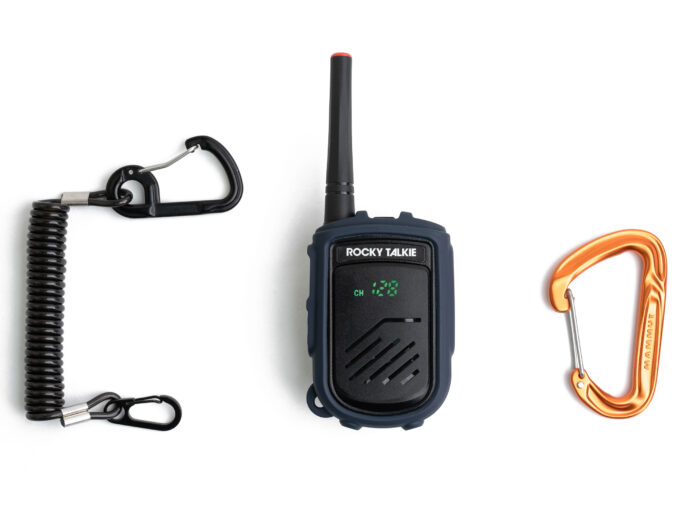
Rocky Talkie power is rated at 2W, with a low-power mode that drops transmission power to 0.5W. The radio is fueled by a 1,550mAh replaceable lithium-ion battery that recharges through an included USB-C charger.
The control button layout is spartan; a large push-to-talk button resides on the left side, along with smaller up-and-down volume buttons that serve other functions when held down for 2 seconds. The top of the unit has a channel toggle with a locking mode, as well as a power button, both somewhat protected from accidental triggering by the thermoplastic housing.
A Mammut Wall Light carabiner threads through a hole in the back of the thermoplastic housing. It was refreshing to see a top-quality, brand-name, full-strength carabiner used in this manner. In a bind, I figured I could use it as a bail ‘biner. A coiled leash with accessory carabiner clips to a small hole in the bottom of the housing.
Finally, a K1-type headset port lies underneath a cover on the right side of the Rocky Talkie.
The Rocky Talkie is rated at IP56, so it’s splashproof but not submergible. The verified weight, with battery, carabiner, and leash, is 8.0 ounces.
In the Field With the Rocky Talkies
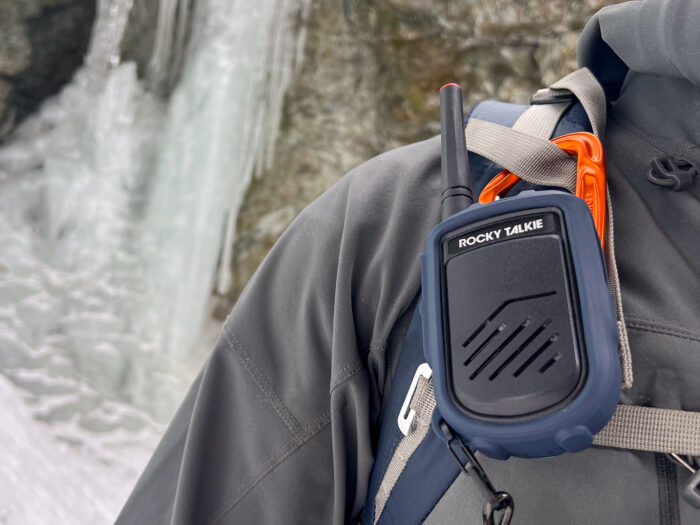
I had enough close calls with miscommunications on climbing routes; yelling over the wind, uncertain rope-tugging signals, and just plain winging it wasn’t in the cards for me anymore. I demanded radio communication at every belay station for anything other than single-pitch cragging, especially while alpine or ice climbing. Near disasters made for great stories, but changing life situations finally forced me to commit to radio communication with my climbing partners.
I had used other FRS radios in the past for various outdoor pursuits, but they were often lacking in range, and, well, I broke all of them in short order. I had used General Mobile Radio Service (GMRS) race radios while riding dirt bikes in Baja, but they were large, heavy, and required an FCC license due to their 5W power rating (I never had one, lol).
The Rocky Talkie emerged in 2019, and it seemed burly in construction and a perfect fit if the brand’s claims panned out.
The Rocky Talkie: Excellent for Ice Climbing
Climbing big ice in Alaska is an exercise in managing unknowables and risks. Is the ice stable? Will the weather hold? Dammit, what is my partner doing now? I can’t see him or hear him. The Rocky Talkie was my solution to mitigating the latter unknowable and associated risks.
On my first outing with the Rocky Talkie in Alaska, we climbed established multipitch routes in Caribou Creek to dial in our systems. Per usual, we paid no regard to longevity or “best practices” in using any of our gear. The Rocky Talkie got dragged up sharp ice and rock, dropped into snow during rests, and smashed and scraped mercilessly — sometimes while hanging on climbing harness gear loops next to ice screws and other metal hardware.
We sometimes climbed or belayed under running water, with air temperatures rarely above 10 degrees Fahrenheit.
The Rocky Talkie performed incredibly well without any issues. The transmissions were much clearer than on other FRS radios; this bolstered my confidence when seconding a route when I hadn’t seen the leader in an hour or more.
I trusted what I heard and never had to ask him to repeat himself. All potential pitfalls and the anchoring situation were knowns before I headed up. And when I was leading, I knew my partner clearly understood the scenario.
I used the radio on a backpack shoulder strap or, when not carrying a pack, on a gear loop on my climbing harness. On the shoulder, speaking in a typical “radio” volume sufficed. On the harness, I had to remove it and hold it next to my mouth for clear transmission.
A much louder voice was necessary when the winds were strong while on the shoulder. If the winds were continuous or we were climbing through a storm, I would have used the optional Rocky Talkie waterproof hand mic if I had had them.
The range during these outings was, at most, a full 70m rope length. So that wasn’t an issue.
The buttons were absolutely perfect for use with gloves. Their size, definitive tactile sensation, and locations were unbeatable. I never miskeyed any of them. This button design should be the standard for any electronics destined for winter use.
Our climbing objectives for this part of the trip were all executed smoothly, and much of this was thanks to the clear communication of the Rocky Talkie. And we did garner a first ascent, naming it “Puck Futin,” for obvious reasons.
A Test of Range
The primary purpose of this trip was a huge, 600-plus-foot, mushrooming waterfall in an incredibly remote area. The only viable access was via helicopter, which put us down more than a mile away. We only had one pair of Rocky Talkies; the other pair within our group was a popular Motorola FRS unit I had used before, but I broke them.
The heli pilot stayed with the chopper to keep the engine warm enough to start and keep fuel from freezing. Over the course of a few hours, we traversed across to the behemoth waterfall, constantly updating the pilot of the situation. And he was to relay information of any rapidly changing weather and subsequent avalanche danger.
The radio communications between us three climbers were constant and clear, both with the Rocky Talkies and with the one Motorola unit. But none of us could hear the pilot’s response, as his radio was out of transmission range. We could listen to him toggle his PTT, but that was it.
The route was too soft, and our screws melted out within minutes, so we had to pack it in and return to the chopper. The pilot informed us that he clearly heard the Rocky Talkie transmissions but not the Motorola. That was proof of the drastically superior transmission range of the Rocky Talkie. The brand claims 1 to 5 miles in the mountains, which was genuine in this case.
A Test of Durability
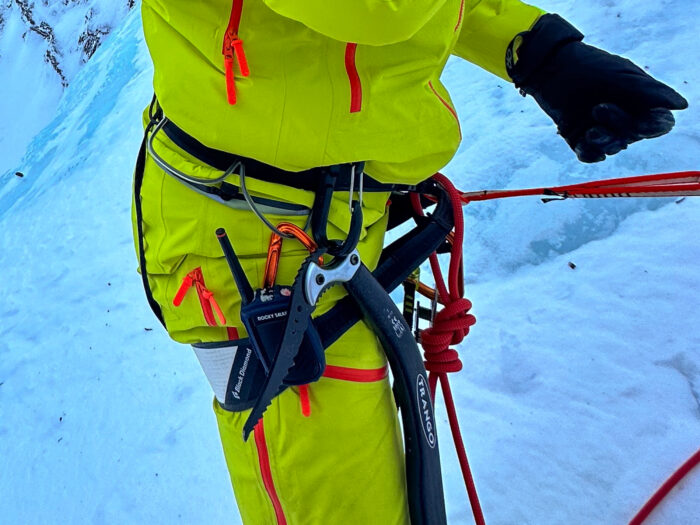
I returned to Alaska the following winter to hunt more first ascents. Because of our last experience with the Rocky Talkie, and the fact that I had yet to break them, my climbing partners bought another pair.
It was the same program: remote objectives, this time all approached by heli. The same sub-10-degree temperatures and harsh gear treatment. But this year, we cut things tighter as far as daylight went.
On two climbs, one garnering another first ascent, we returned to the heli with just enough time to fly out in fading light. We had to remove all sharp gear from our bodies and stow them under the heli seats to protect vital components in the cramped cabin. And both times, the Rocky Talkies were clipped to harnesses, which were quickly dropped, tossed, and haphazardly stuffed into underseat storage, along with axes, ice screws, snowshoes, and crampons.
None of the radios emerged from these hurried junk fests with any functional damage.
My set of radios has two big, multipitch ice seasons on them. Although this might not seem like much, I’ve shredded shell systems and gloves into unusable form on a single route. Some shell pants were pulverized on a single pitch. I’ve dulled crampons and axes within a few days. And helmets have returned home from one trip so dented that I didn’t use them again.
Of all the things I do, ice climbing in Alaska is the most concentrated crucible of gear wear I have yet to experience. The Rocky Talkie thrived and has earned my trust for harsh use.
Rocky Talkie Battery Life
Rocky Talkie claims a 3- to 5-day battery life, even when used in icy conditions. I found this claim accurate on both week-long Alaskan ice-climbing trips. I didn’t recharge my radio unless I saw the battery life indicator dip below 50%, which didn’t happen until after at least 2 full days of climbing.
A Few Downsides
Overall, I loved the Rocky Talkie and considered it perfect for big ice. But as an outdoor communication tool, I saw three potential downsides.
One is that the radio isn’t waterproof, which takes it out of paddlesports. For other endeavors that may include rain, the IP56 rating suffices. And one could keep the radio under a shell and use the optional waterproof hand mic.
The next potential downside is the lack of NOAA weather information. Rocky Talkie claims the omission keeps the radios small and light. And as a climber that used the radios continuously en route, I agree with this decision. I checked the weather before leaving each day, and then just made decisions based on what I saw. If I really needed a weather update, we always had other means. But this may not be true for others.
Lastly, the proprietary battery could be an issue on extended expeditions when recharging isn’t an option. The solution is to purchase extra Rocky Talkie batteries. This may be more expensive and require more logistical planning compared to standard batteries, but it is a solution.
The Rocky Talkie: Conclusions
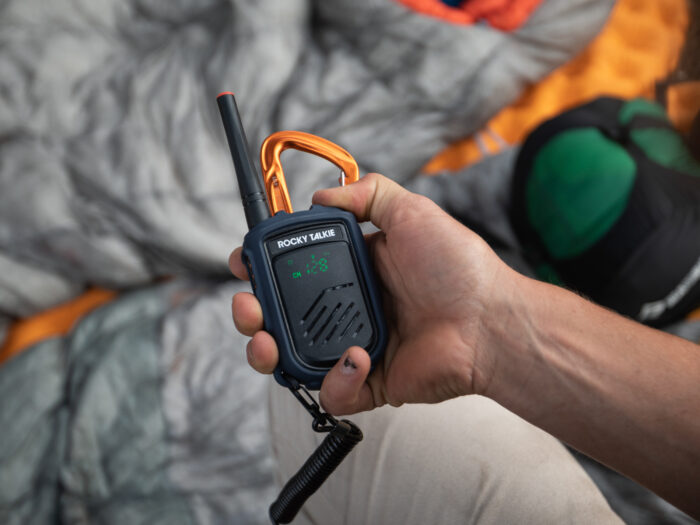
I don’t think there is a better no-license radio communication device for most climbing than the Rocky Talkie, especially considering the MSRP of $110 each. The only other radio system I’ve used that has survived more than one season is a GMRS “race radio,” which is twice as big, three times as heavy, and costs four times as much.
The Rocky Talkie was simple to operate, delivered clear transmissions, had long battery life in extremely cold conditions, and, most importantly, emerged unscathed from the harshest treatment.
No, it’s not waterproof and doesn’t deliver NOAA forecasts. But for climbing and most other things I do, I’d rather have the smaller form factor and lighter weight. One of these may be a deal-killer for some.
For land-based outdoor activities, I feel that the Rocky Talkie is hard to beat.
